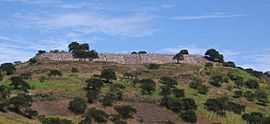Kuntur Wasi facts for kids

View of the main platform of the archaeological site of Kuntur Wasi
|
|
| Location | San Pablo, San Pablo Province, Cajamarca |
|---|---|
| Coordinates | 07°07′46″S 78°50′43″W / 7.12944°S 78.84528°W |
| Type | Sanctuary |
| History | |
| Periods | Initial Period |
| Cultures | Chavín |
Kuntur Wasi is an ancient site in the Andes mountains of Peru. Its name means "condor house" in the Quechua language. It was once a special religious center with amazing buildings and stone carvings. Experts believe the people who lived here were connected to the famous Chavín culture.
Contents
Where is Kuntur Wasi Located?
Kuntur Wasi is found in the northern mountains of Peru. It sits near the start of the Jequetepeque River. This area is close to the city of Cajamarca and the small town of San Pablo. The Jequetepeque valley was like an ancient highway. It helped people travel between the coast and the highlands. Kuntur Wasi was a place where many people gathered.
How Old is Kuntur Wasi?
This ancient site was likely built a very long time ago. It is thought to have been constructed between 1000 and 700 BCE. This time period is known as the Initial Period in ancient Peruvian history. The site was used by people from about 1200 BCE to 50 BCE.
What Does Kuntur Wasi Look Like?
The buildings at Kuntur Wasi are quite impressive. There is a temple built on top of a hill. You can also see square-shaped platforms and a courtyard that is sunken into the ground. Many different rooms are also part of the complex.
In one of these rooms, a special clay figure was found. It looks like a human and is about 30 inches (75 cm) tall. This figure is painted with bright colors. These colors include red, green, black, yellow, and pink. Its face has large square eyes and a wide mouth with big teeth.
The site also features platforms with steps. These steps might have been used for ceremonies. There are also special structures where people were buried.
Amazing Stone Carvings
Many stone carvings, called lithosculptures, have been discovered at Kuntur Wasi. These carvings show designs of snakes and big cats. Their style is very similar to the art of the Chavín culture. The carvings you see at the site today are copies. The original ones have been moved to museums to protect them.
Discovery and Treasures
The Kuntur Wasi site was first found in 1945 by a famous archaeologist named Julio C. Tello. Later, in 1989, scientists from the University of Tokyo started digging there. They found four ancient tombs at Kuntur Wasi.
Inside these tombs, they discovered many valuable items. These included gold necklaces worn on the chest. They also found gold crowns and beautiful stone beads. Earrings and sets of dishes were also among the treasures. Some items even had pictures of people carved on them. Since the University of Tokyo began its work, a total of eight tombs have been found.
Kuntur Wasi Museum
To share these amazing discoveries, the Kuntur Wasi Museum opened in 1994. Local people manage this museum. It allows visitors to learn more about the history and treasures of Kuntur Wasi.
Gallery
-
Chavinoid relief of Kuntur Wasi, note the tusks and face tabby typical of Chavín art
See also
 In Spanish: Kuntur Wasi para niños
In Spanish: Kuntur Wasi para niños





